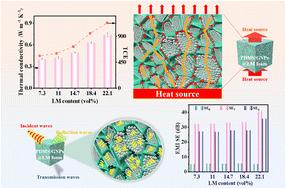当前位置:
X-MOL 学术
›
J. Mater. Chem. A
›
论文详情
Our official English website, www.x-mol.net, welcomes your
feedback! (Note: you will need to create a separate account there.)
Dual network structures of PDMS-based composite foam via anchoring liquid metal nanoparticles for improved thermal conductivity and electromagnetic interference shielding performances
Journal of Materials Chemistry A ( IF 10.7 ) Pub Date : 2024-09-18 , DOI: 10.1039/d4ta04436c Ying Zhang, Song Yang, Yilin Liu, Ting Gu, Fei Liu
Journal of Materials Chemistry A ( IF 10.7 ) Pub Date : 2024-09-18 , DOI: 10.1039/d4ta04436c Ying Zhang, Song Yang, Yilin Liu, Ting Gu, Fei Liu

|
Despite their promising application prospects in electromagnetic interference (EMI) shielding, a significant challenge remains in endowing flexible porous polymer-based conductive composites with exceptional thermal management capabilities. In this study, PDMS/GNPs foam serves as a three-dimensional (3D) porous skeleton, with LM nanoparticles anchored on its surface, creating a poly(dimethylsiloxane)/graphene nanoplatelets@liquid metal (PDMS/GNPs@LM) composite foam with a dual network structure, achieved through a simplified salt template and extrusion impregnation method. Owing to the successful construction of this dual 3D network structure, when the filler loading is 22.34 vol%, PDMS/GNPs@LM foam exhibits an excellent thermal conductivity of 0.74 W m−1 K−1, representing a 1133% enhancement compared to the neat PDMS foam. Finite element simulations demonstrate that the LM layer network exhibits excellent heat transmission due to the effective adhesion of adjacent LM nanoparticles via the polyvinyl alcohol adhesives, with heat flux mainly transferred through the continuous LM framework. The PDMS/GNPs@LM foam possesses an outstanding electrical conductivity of 35.15 S m−1 and excellent EMI shielding effectiveness of 40.8 dB (with a thickness of only 2.13 mm). Furthermore, the PDMS/GNPs@LM foams demonstrate good mechanical flexibility and exhibit rapid electrothermal response and hydrophobicity. Based on these merits, the PDMS/GNPs@LM foam is anticipated to find applications in electronics, particularly in intelligent electromagnetic protection and thermal management systems.
中文翻译:

基于PDMS的复合泡沫的双网络结构通过锚定液态金属纳米粒子来提高导热性和电磁干扰屏蔽性能
尽管它们在电磁干扰(EMI)屏蔽方面具有广阔的应用前景,但赋予柔性多孔聚合物基导电复合材料卓越的热管理能力仍然是一个重大挑战。在这项研究中,PDMS/GNPs 泡沫作为三维 (3D) 多孔骨架,LM 纳米颗粒锚定在其表面,形成聚(二甲基硅氧烷)/石墨烯纳米片@液态金属 (PDMS/GNPs@LM) 复合泡沫,双网络结构,通过简化的盐模板和挤压浸渍方法实现。由于这种双3D网络结构的成功构建,当填料用量为22.34 vol%时,PDMS/GNPs@LM泡沫表现出优异的导热系数,达到0.74 W m −1 K −1 ,比传统的导热系数提高了1133%。整齐的 PDMS 泡沫。有限元模拟表明,由于相邻的LM纳米粒子通过聚乙烯醇粘合剂有效粘合,LM层网络表现出优异的传热性能,热通量主要通过连续的LM框架传递。 PDMS/GNPs@LM泡沫具有35.15 S m -1的优异电导率和40.8 dB的优异EMI屏蔽效能(厚度仅为2.13 mm)。此外,PDMS/GNPs@LM 泡沫表现出良好的机械灵活性,并表现出快速的电热响应和疏水性。基于这些优点,PDMS/GNPs@LM泡沫预计将在电子领域得到应用,特别是在智能电磁保护和热管理系统中。
更新日期:2024-09-21
中文翻译:

基于PDMS的复合泡沫的双网络结构通过锚定液态金属纳米粒子来提高导热性和电磁干扰屏蔽性能
尽管它们在电磁干扰(EMI)屏蔽方面具有广阔的应用前景,但赋予柔性多孔聚合物基导电复合材料卓越的热管理能力仍然是一个重大挑战。在这项研究中,PDMS/GNPs 泡沫作为三维 (3D) 多孔骨架,LM 纳米颗粒锚定在其表面,形成聚(二甲基硅氧烷)/石墨烯纳米片@液态金属 (PDMS/GNPs@LM) 复合泡沫,双网络结构,通过简化的盐模板和挤压浸渍方法实现。由于这种双3D网络结构的成功构建,当填料用量为22.34 vol%时,PDMS/GNPs@LM泡沫表现出优异的导热系数,达到0.74 W m −1 K −1 ,比传统的导热系数提高了1133%。整齐的 PDMS 泡沫。有限元模拟表明,由于相邻的LM纳米粒子通过聚乙烯醇粘合剂有效粘合,LM层网络表现出优异的传热性能,热通量主要通过连续的LM框架传递。 PDMS/GNPs@LM泡沫具有35.15 S m -1的优异电导率和40.8 dB的优异EMI屏蔽效能(厚度仅为2.13 mm)。此外,PDMS/GNPs@LM 泡沫表现出良好的机械灵活性,并表现出快速的电热响应和疏水性。基于这些优点,PDMS/GNPs@LM泡沫预计将在电子领域得到应用,特别是在智能电磁保护和热管理系统中。











































 京公网安备 11010802027423号
京公网安备 11010802027423号